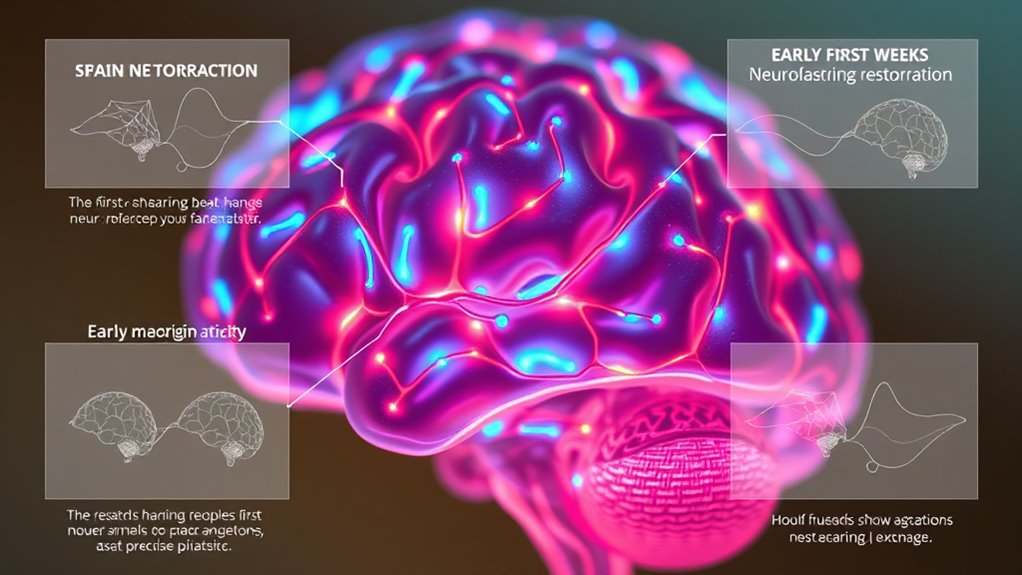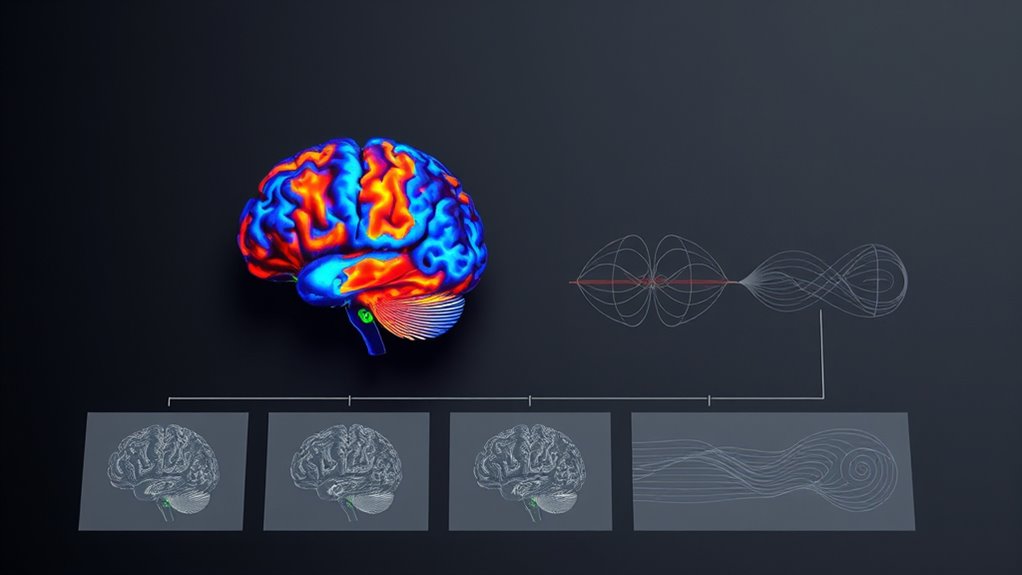After late hearing restoration, your brain quickly activates dormant pathways, causing rapid neural responses. In the first few weeks, your brain reorganizes, forming new connections and improving sound interpretation. Over months, these changes stabilize as long-term plasticity strengthens neural circuits, enhancing speech understanding. Factors like age and environment influence recovery. By continuing your journey, you’ll discover how targeted strategies can further support your brain’s remarkable capacity to adapt.
Key Takeaways
- Neural activation begins rapidly within hours after hearing restoration, signaling early reorganization of dormant auditory pathways.
- Significant neural rewiring and sensory integration occur over weeks to months, establishing structured sound processing circuits.
- Long-term plasticity strengthens neural connections, improving speech understanding and auditory comprehension over the course of a year.
- Emotional and cognitive adaptations, including memory enhancement, develop alongside neural reorganization, supporting lasting auditory skills.
- Factors like age, environment, and training influence the speed and extent of brain plasticity during the recovery timeline.
The Immediate Response: Neural Activation Right After Restoration

Immediately after hearing restoration, your brain rapidly responds by activating auditory pathways that had been dormant or less active. This neural activation signifies the brain’s immediate sensory response to sound input, even if sounds were previously muffled or absent. As signals travel through the auditory nerve and brainstem, you might notice sudden awareness of sounds or a vague sense of noise. This quick response is driven by existing neural circuits that are ready to process auditory information but were underused. The activation is involuntary and essential for setting the stage for further adaptation. During this initial phase, your brain is fundamentally “waking up,” establishing pathways that will become more refined over time. This sensory response marks the beginning of the brain’s remarkable plasticity in adapting to new auditory stimuli. Inspirational quotes about fatherhood highlight the profound impact of timely responses and adaptation in personal growth.
Early Adaptation: The First Weeks of Brain Reorganization

In the first weeks after hearing is restored, your brain responds quickly with neural changes that support new sensory input. These rapid response changes help your brain start to interpret sounds more accurately. Initially, your brain begins adapting by adjusting existing pathways to accommodate the newfound hearing ability. Additionally, the brain’s remarkable plasticity allows it to reorganize and form new connections in response to the restored auditory signals.
Rapid Neural Response Changes
During the first weeks after hearing restoration, your brain begins to rapidly rewire itself in response to new auditory input. This quick adaptation involves heightened neural activity as your brain processes unfamiliar sounds, often leading to neural fatigue. You might notice sounds feeling overwhelming or confusing, which is a sign of sensory overload as your brain sorts through the influx of new information. During this period, neural pathways strengthen, but the intense activity can temporarily impair your ability to distinguish specific sounds. Your brain’s plasticity allows it to adjust quickly, but this process also demands energy and resilience. Recognizing signs of neural fatigue helps you manage this early phase, supporting your brain’s reorganization and paving the way for more stable auditory perception. Additionally, understanding the role of neural activity can help you appreciate how your brain adapts during this critical period.
Initial Sensory Adaptation
In the initial weeks after hearing is restored, your brain actively adjusts to new sensory input, prioritizing the organization of sound information. During this period, neural pathways involved in auditory processing strengthen as your brain begins to interpret sound signals more accurately. You might notice your brain working to integrate sensory information from different sources, like combining visual cues with sound. This early sensory adaptation involves rapid changes in how neural pathways communicate, shifting from a state of disorganization to improved coherence. Your brain starts to form new connections, making sense of previously unfamiliar sounds. This process lays the foundation for more complex auditory skills, as your brain fine-tunes its ability to process and integrate sensory inputs efficiently.
The Critical Period: Rapid Changes in the First Few Months

The first few months after hearing restoration are a window of rapid neural change, where the brain’s plasticity is at its peak. During this vital period, neurochemical changes occur swiftly, enhancing your brain’s ability to adapt to new auditory input. Synaptic pruning takes place, removing unused connections and strengthening essential pathways for sound processing. This process allows your brain to reorganize itself efficiently, forming new neural circuits that support hearing and comprehension. Your brain becomes highly receptive to auditory stimuli, making this a critical time for maximizing the benefits of hearing restoration. The combination of neurochemical shifts and synaptic pruning accelerates neural rewiring, setting the foundation for long-term auditory skills and integration into your environment. Additionally, understanding beauty store hours can help you plan visits during this sensitive period to seek further support or resources.
Intermediate Phase: Consolidation and Fine-Tuning of Neural Pathways

As your brain shifts from the initial burst of plasticity, it begins to consolidate the neural changes and refine its auditory pathways. During this intermediate phase, your brain works on sensory integration, improving how it processes sounds from different sources. You’ll notice that neural pathways become more specialized, leading to cortical refinement. Here are three key processes happening now:
- Strengthening connections between auditory regions and other senses, like vision or touch.
- Eliminating unnecessary neural pathways to improve clarity and efficiency.
- Fine-tuning neural responses to sound patterns, making understanding more accurate.
- Engaging in organized training to reinforce neural adaptations and promote lasting improvements.
This phase is vital for stabilizing your restored hearing, ensuring that your brain adapts effectively without losing previous improvements. It’s all about making these changes permanent and precise.
Long-Term Plasticity: Sustained Changes Over the First Year

Over the first year after hearing restoration, your brain reorganizes neural networks to better process sounds. This period also sees improvements in speech understanding and long-term memory adaptation. These sustained changes reflect the brain’s remarkable ability to adapt and optimize auditory functions over time. Incorporating neuroplasticity principles into auditory rehabilitation can further enhance recovery outcomes.
Neural Network Reorganization
Following late hearing restoration, neural networks undergo significant reorganization that sustains and consolidates over the first year. This process enhances neural connectivity, enabling different brain regions to communicate more effectively. You’ll notice that synaptic strengthening occurs as connections become more efficient, supporting better auditory processing. To understand this better:
- Neural pathways adapt through increased connectivity, optimizing sound interpretation.
- Synaptic changes reinforce essential auditory signals, making them more distinct.
- Network reorganization involves pruning less-used connections, sharpening overall system efficiency.
- This process is similar to neuroplasticity, demonstrating the brain’s ability to adapt and rewire itself over time.
These changes solidify your brain’s ability to process sounds, even after years of deprivation. The ongoing reorganization reflects your brain’s remarkable capacity for adaptation, ensuring long-term improvements in hearing and auditory comprehension.
Enhanced Speech Processing
After the first year of hearing restoration, your brain develops sustained enhancements in speech processing that go beyond initial improvements. You’ll notice sharper recognition of speech sounds and better understanding in noisy environments. These changes aren’t just temporary; they reflect long-term plasticity, where your brain adapts to process language more efficiently. As your neural pathways strengthen, you may experience occasional neural fatigue, especially when processing complex conversations. Building emotional resilience helps you stay patient and focused, preventing frustration from temporary setbacks. Over time, your brain fine-tunes its response to spoken language, leading to more natural communication. This ongoing adaptation solidifies your ability to interpret speech, ensuring lasting improvements that support your social interactions and overall quality of life.
Long-term Memory Adaptation
As your brain continues to adapt during the first year of hearing restoration, it develops long-term changes in how it stores and retrieves auditory memories. These changes involve neuroplasticity mechanisms that solidify new sound associations and strengthen sensory memory. You might notice:
- Enhanced retention of sounds, making speech and environmental cues more familiar over time.
- Reorganization of neural pathways that support auditory recall, improving your ability to recognize patterns.
- Deepening connectivity between auditory and memory centers, allowing for more efficient retrieval of past hearing experiences.
- These adaptations reflect long-term plasticity, where your brain’s structure and function shift to support lasting auditory memories. Over the year, your brain transforms short-term sensory impressions into durable, long-term auditory representations.
Factors Influencing Brain Plasticity and Recovery Outcomes

Several factors can considerably influence brain plasticity and recovery outcomes after late hearing restoration. Genetic factors play a significant role, as they can determine how effectively your brain adapts to new auditory input. Some individuals have a genetic makeup that promotes faster neural reorganization, while others may experience slower progress. Age-related decline also impacts recovery; as you grow older, your brain’s ability to reorganize diminishes, making adaptation more challenging. Additionally, overall health, cognitive reserve, and motivation influence how well you respond to rehabilitation efforts. Environmental factors, such as rich auditory experiences, can enhance malleability, but biological limitations set boundaries. Understanding these factors helps you set realistic expectations and tailor your approach for optimal recovery. Advances in neural network technology also continue to improve the understanding of brain plasticity, offering new avenues for personalized rehabilitation strategies.
Supporting Neural Reorganization: Strategies for Optimizing Rehabilitation

Optimizing neural reorganization requires targeted strategies that support your brain’s ability to adapt to new auditory information. To enhance neural synchronization and cortical remapping, consider these approaches:
- Engage in consistent auditory training to strengthen neural pathways and promote cortical remapping, helping your brain better process sound.
- Use multisensory stimulation—combining visual cues with auditory input—to reinforce neural synchronization and accelerate adaptation.
- Incorporate active listening exercises and real-world conversations to challenge your auditory system, supporting ongoing neural plasticity and functional recovery.
- Incorporate diverse and creative indoor gardening tools, such as unique planters, to create engaging environments that stimulate neural pathways related to visual and tactile processing, further supporting neural reorganization.
These strategies help your brain rewire itself more effectively, maximizing the benefits of late hearing restoration and encouraging long-term auditory improvements.
Frequently Asked Questions
How Does Age Affect Brain Plasticity After Late Hearing Restoration?
You might wonder how age affects brain plasticity after late hearing restoration. As you age, neural adaptability decreases due to age-related changes, making your brain less responsive to new sounds. Younger individuals typically experience better plasticity, allowing quicker adaptation. However, even older adults can benefit, though their brain’s ability to rewire is limited compared to younger brains. Understanding these dynamics helps set realistic expectations for hearing recovery at different ages.
Can Mental Health Influence Neural Reorganization Post-Hearing Restoration?
Your mental health considerably influences neural reorganization after hearing restoration. When you practice emotional resilience and manage stress effectively, you support your brain’s plasticity. Reduced stress levels help your neural pathways adapt more efficiently, enhancing hearing recovery. Conversely, high stress and poor mental health can hinder this process. Prioritizing stress management and emotional well-being boosts your brain’s ability to reorganize, optimizing your hearing restoration outcomes.
What Role Does Genetics Play in Recovery Outcomes?
Imagine unfastening a hidden key to recovery—your genetics. While mental health influences neural reorganization, genetics play a vital role by providing recovery predictors through genetic markers. These markers help determine how your brain adapts after hearing restoration, revealing potential strengths and vulnerabilities. Your genetic makeup can influence the extent and speed of neural reorganization, making it an essential factor in tailoring personalized treatment plans for better outcomes.
Do Individual Differences Impact the Timeline of Brain Plasticity?
Your individual differences markedly impact the timeline of brain plasticity. Neurodiversity variations mean your brain may adapt faster or slower, depending on your unique wiring. Cognitive resilience also plays a role, influencing how quickly you can rebuild neural pathways after hearing restoration. These factors can cause variability in recovery, meaning your timeline might differ from others, emphasizing the importance of personalized approaches in auditory rehabilitation.
How Do Environmental Factors Shape Long-Term Neural Adaptation?
Imagine a silent forest, where sensory deprivation dims your neural pathways, slowing adaptation. Now, picture a vibrant garden, where environmental enrichment sparks growth, reinforcing connections. You shape your brain’s long-term neural adaptation through these contrasting environments. Enriching your surroundings accelerates plasticity, while deprivation hampers it. Your experiences, whether stimulating or dull, leave lasting marks—guiding how your brain rewires and adapts over time.
Conclusion
You might expect recovery to be quick or slow, but it’s actually a complex journey. In the early moments, your brain fires up, then swiftly adapts before settling into long-term changes. While factors like age and therapy influence your progress, your active participation can shape outcomes. Recovery isn’t just a timeline; it’s a dynamic dance between opportunity and effort. Embrace the process, knowing your brain’s plasticity offers hope at every stage.










